Why Kitchen Island Material Matters
A kitchen island isn’t just an architectural centerpiece; it’s the hub of family meals, friendly gatherings, quick breakfasts, and creative cooking. From its kitchen island materials to design, the island plays a vital role in defining not only the style but also the functionality of your dream kitchen.
But one question often stumps homeowners: What is the best material for a durable kitchen island? With countless choices in kitchen island top materials, it can be overwhelming to select one that checks all the boxes—durable, stylish, heat- and scratch-resistant, low maintenance, and budget-friendly.
In this comprehensive guide, we’ll dive into the types of kitchen island materials—including options ideal for outdoor kitchens—and help you choose the best material for kitchen island and countertop use.
Understanding Kitchen Island Functions: Tailoring Material Choices to Daily Use
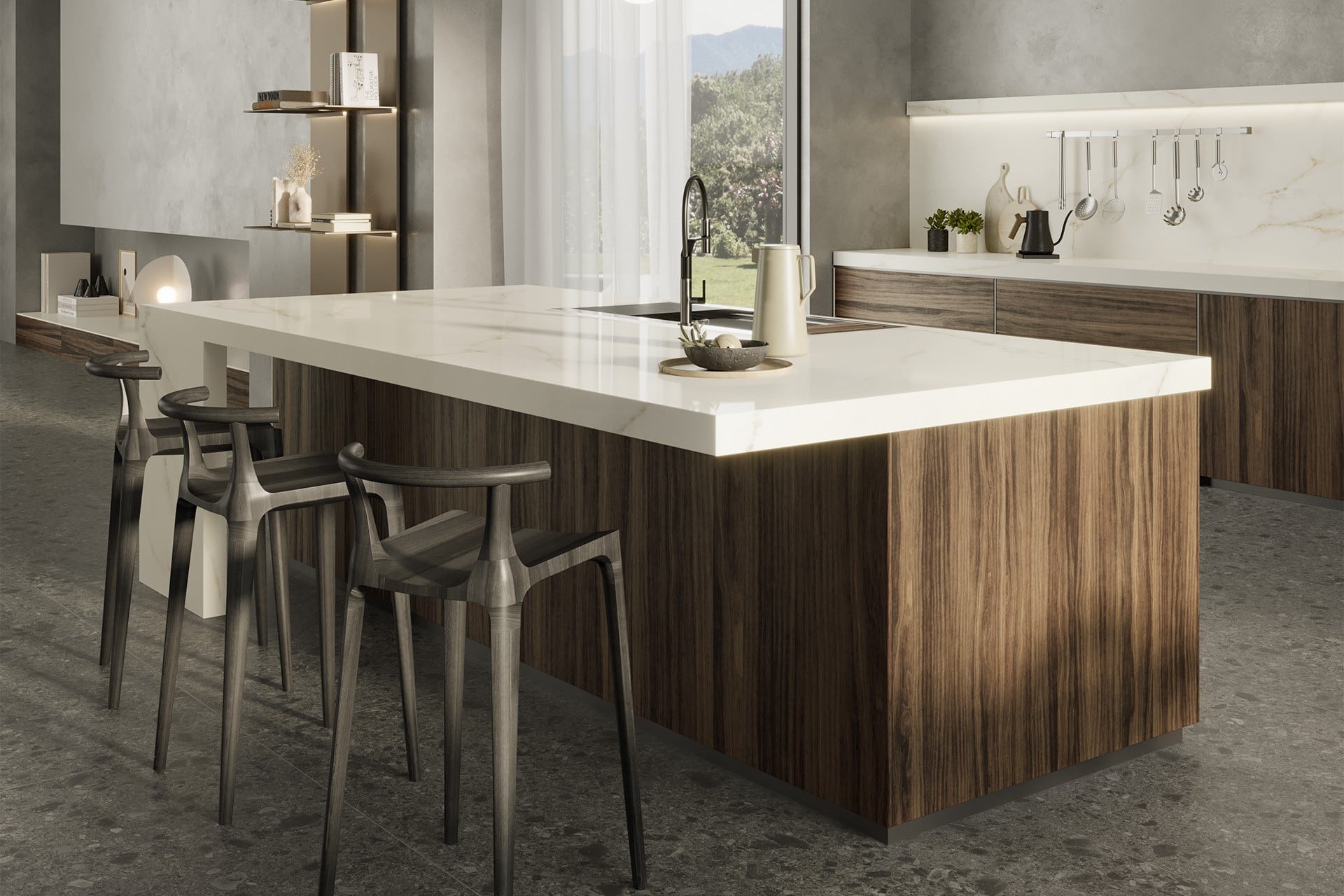
When designing a kitchen island, one of the most crucial decisions you’ll make involves understanding its intended functionality. This informs everything from frame material to countertop selection and even storage design.
A kitchen island can fulfill multiple roles depending on your household needs:
1. Food Preparation Zone
If your kitchen island will primarily be used for food prep, you’ll need a scratch-resistant, heat-tolerant, and stain-proof surface. Materials like granite, quartzite, and stainless steel are ideal due to their resilience under frequent use, sharp utensils, and exposure to oils and acidic ingredients.
2. Dining and Gathering Area
For islands that double as informal dining spaces or breakfast bars, focus on comfort and aesthetics. Here, butcher block, solid surface, and quartz shine due to their tactile warmth and appealing colors and patterns. These materials are less industrial-looking and more welcoming for sit-down meals.
3. Storage-Heavy Designs
If you need extra storage, your island must integrate drawers, cabinets, and shelves. This will influence your frame material choice. Strong wood frames or metal frames should be selected to support weight distribution and ensure long-term durability.
Explore real-life examples of efficient kitchen storage in our remodeling portfolio.
4. Appliance and Sink Integration
Planning to incorporate a cooktop, sink, or mini fridge into your island? This demands waterproof, heat-resistant, and structurally sound materials. Choose surfaces like quartz, granite, or concrete, and frame materials that allow proper cladding, wiring, and plumbing.
For water-heavy zones, consider learning more about our waterproofing solutions.
5. Entertainment and Multi-use Spaces
Kitchen islands often serve as gathering spaces during parties or family get-togethers. In this case, prioritize materials that offer a visual statement—like quartzite or custom concrete finishes—while withstanding light beverage spills or heat from serving dishes.
Pro Tip: If you’re seeking a flexible and cost-effective option, an IKEA kitchen island offers customizable configurations with wood and stainless steel tops. These modular options are ideal for smaller kitchens or renters.
For permanent or built-in installations, prioritize durable kitchen island materials that enhance the room’s longevity and resale value.
1. Natural Stone Countertops: Premium Strength and Visual Appeal
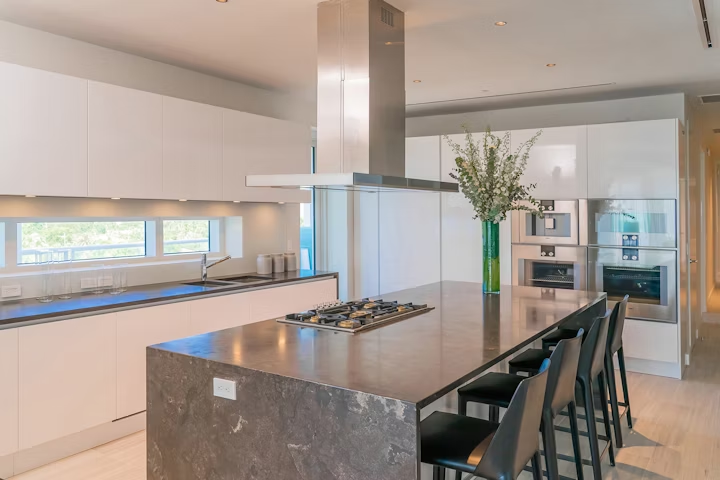
a. Granite: A Timeless Powerhouse in Kitchen Design
Granite is frequently regarded as the gold standard for kitchen island countertops, and with good reason. This natural stone delivers a unique combination of durability, heat tolerance, and high-end aesthetics.
Key Benefits of Granite Countertops
-
Heat Resistance: Granite can withstand hot pans, boiling water, and radiant heat from appliances without warping or discoloration.
-
Scratch Resistance: Due to its dense mineral structure, granite resists knife marks and scuffs from heavy kitchen tools.
-
Aesthetic Variety: Each granite slab is one-of-a-kind, with swirling patterns and natural speckles in diverse shades—from muted earth tones to dramatic black-and-white contrasts.
-
Property Value Boost: Real estate professionals often cite granite countertops as a positive selling point in home listings.
Considerations Before Choosing Granite
-
Sealing Required: While granite is fairly stain-resistant, its porous surface means it needs to be sealed every 1–2 years to prevent discoloration from oils, wine, or juice.
-
Investment Cost: Granite is among the more expensive countertop materials, especially if you’re choosing rarer colors or thicker cuts.
Ideal Use Cases
Granite is best suited for heavy-use kitchen islands where daily food prep, cooking, serving, and even entertaining take place. Its rugged durability ensures that it holds up under both aesthetic and functional demands.
Learn more about how granite fits into trending kitchen designs in our blog on top remodeling ideas.
b. Quartzite: A Blend of Marble Elegance and Granite Strength
Often confused with quartz, quartzite is a natural metamorphic stone that offers the luxurious look of marble combined with the hardiness of granite. It’s quickly becoming a favorite among homeowners who want both beauty and functionality in their kitchen island materials.
Advantages of Quartzite
-
Durability Similar to Granite: Formed from sandstone under intense heat and pressure, quartzite is hard and highly resistant to scratches, chips, and etching.
-
Heat Resistance: Like granite, quartzite can handle hot pots and pans with ease.
-
Marble-Like Aesthetic: Offers the soft veining and luminosity of marble without the maintenance burden.
-
Unique Patterns: Naturally occurring striations and variations make every slab a visual standout.
Downsides to Keep in Mind
-
Sealing Still Necessary: Though more resilient than marble, quartzite is still porous and must be sealed periodically to resist staining.
-
Cost: Slightly more expensive than granite in some regions due to its rising popularity and limited quarry sources.
Where It Works Best
Quartzite is perfect for luxury kitchen islands or statement pieces in open-plan living spaces where the island is on display. It balances elegance with resilience, making it suitable for both hosting and hardcore cooking.
Need more inspiration for material matching and full-surface integration? Try our multi-surface visualizer tool to test color and material combinations before making a final decision.
2. Engineered Surfaces: Style Meets Practical Performance

a. Quartz: The Champion of Low-Maintenance Elegance
Quartz countertops, also known as engineered stone, are manufactured from crushed quartz crystals mixed with resin binders and pigments. This innovative process creates an extremely durable, non-porous surface that rivals natural stone in appearance but offers a number of practical advantages.
Advantages of Quartz Countertops
-
Non-Porous Surface: Quartz does not require sealing, making it inherently resistant to bacteria, stains, and moisture damage—an excellent option for busy households.
-
Durability: While not as hard as granite, quartz is scratch- and impact-resistant, making it well-suited for high-traffic kitchen islands.
-
Aesthetic Versatility: Available in hundreds of colors and patterns, including designs that mimic marble, concrete, or granite, quartz allows for seamless integration with various kitchen themes.
Drawbacks to Consider
-
UV Sensitivity: Prolonged exposure to direct sunlight may cause some quartz colors to fade or discolor over time.
-
Heat Resistance: Though it can tolerate moderate heat, quartz is not as heat-resistant as granite or stainless steel. It is best to avoid placing hot pots directly on the surface.
Ideal Applications
Quartz is perfect for family-friendly kitchen islands and homeowners seeking a polished, cohesive look without constant upkeep. Its cleanability and design flexibility make it a top contender in contemporary kitchens.
🔗 Explore more about kitchen remodeling services, where we guide you in choosing premium quartz options tailored to your space.
b. Solid Surface (Corian): Seamless Modernity
Solid surface materials like Corian are a popular choice in modern kitchen design. Made from a blend of acrylic polymers and natural minerals, these surfaces offer a clean, smooth appearance with seamless transitions between sinks, backsplashes, and countertops.
Key Advantages
-
Seamless Design: Unlike stone, solid surface countertops can be fabricated with no visible joints, creating a unified, elegant finish.
-
Design Flexibility: Available in a broad spectrum of colors and patterns, including bold contemporary tones and soft neutrals.
-
Easy to Repair: Minor scratches and burns can be sanded or buffed out, extending the life of the surface.
Disadvantages
-
Lower Heat Tolerance: Solid surface materials can be damaged by high temperatures, so hot pans should always be placed on trivets.
-
Prone to Scratches: These surfaces can scratch more easily than quartz or granite, particularly in high-use areas.
Best Use Cases
Solid surface countertops are best suited for sleek, modern kitchen islands where style, cleanliness, and a unified look are key. Their non-porous nature also makes them ideal for allergy-sensitive households.
🔗 See more about bathroom vanities and modern surface selections to complement your kitchen with similar material continuity.
3. Wood & Butcher Block: A Rustic, Warm Choice for Traditional Kitchens

Wood and butcher block countertops bring a sense of organic warmth and classic craftsmanship to the kitchen. Whether you’re aiming for a country farmhouse vibe or Scandinavian minimalism, these kitchen island materials add texture and comfort to any space.
Key Benefits
-
Visual Warmth: Wood naturally softens the look of a kitchen and pairs beautifully with both painted cabinetry and stainless appliances.
-
Surface Repairability: Small scratches or cuts can be sanded out and refinished, restoring the original surface with ease.
-
Functional Surface: With proper care, butcher block can serve as a practical prep surface for chopping, baking, and rolling dough.
Considerations for Use
-
Regular Maintenance: Wood is a living material that expands and contracts. It needs to be oiled routinely to prevent cracking or drying out.
-
Moisture Sensitivity: Prolonged exposure to water can cause warping or bacterial buildup. It’s important to wipe up spills immediately and use protective sealants.
Perfect Fit
Butcher block kitchen islands are ideal for homes embracing a farmhouse, rustic, or transitional style. When combined with wood frames and open shelving, they offer a timeless and cozy appeal.
🔗 Protect your investment with expert tips in our guide on professional cabinet installation to ensure your wood features last for years to come.
4. Stainless Steel: Commercial Strength Meets Minimalist Design
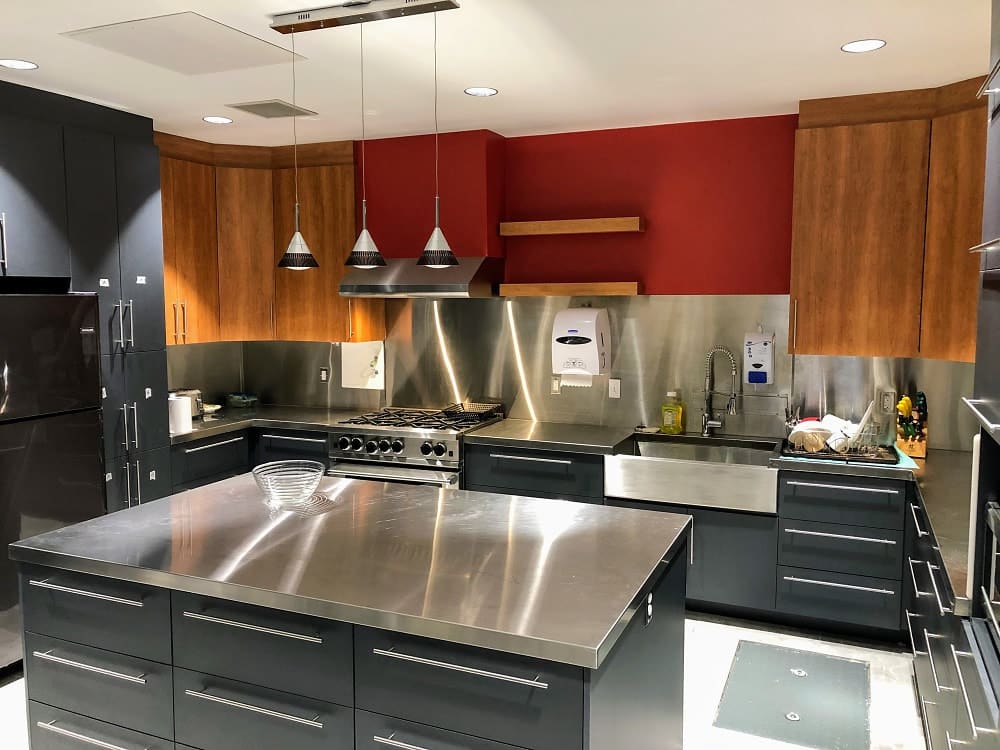
Key Strengths
-
Hygienic and Non-Porous: Stainless steel does not harbor bacteria, making it one of the most sanitary kitchen island materials available.
-
Water and Heat Resistance: It can withstand extreme temperatures and constant exposure to moisture, making it a great choice for islands with built-in sinks or cooktops.
-
Durability: Resistant to rust, warping, and cracking, this material can endure decades of wear and tear with minimal effort.
Potential Drawbacks
-
Surface Marks: It is susceptible to scratches, dents, and fingerprints, especially in high-use areas.
-
Industrial Look: The sleek metallic finish may not blend well with traditional or farmhouse-style interiors.
Best Use Cases
Stainless steel is an excellent choice for minimalist kitchens, loft-style interiors, or outdoor living areas where durability and ease of cleaning are top priorities. It pairs well with metal frames and offers a sleek, professional look.
🔗 Considering an outdoor expansion? Check out our home addition services to see how a stainless steel island can complement your backyard kitchen or entertaining space.
5. Concrete: Sculptural Strength and Industrial Charm
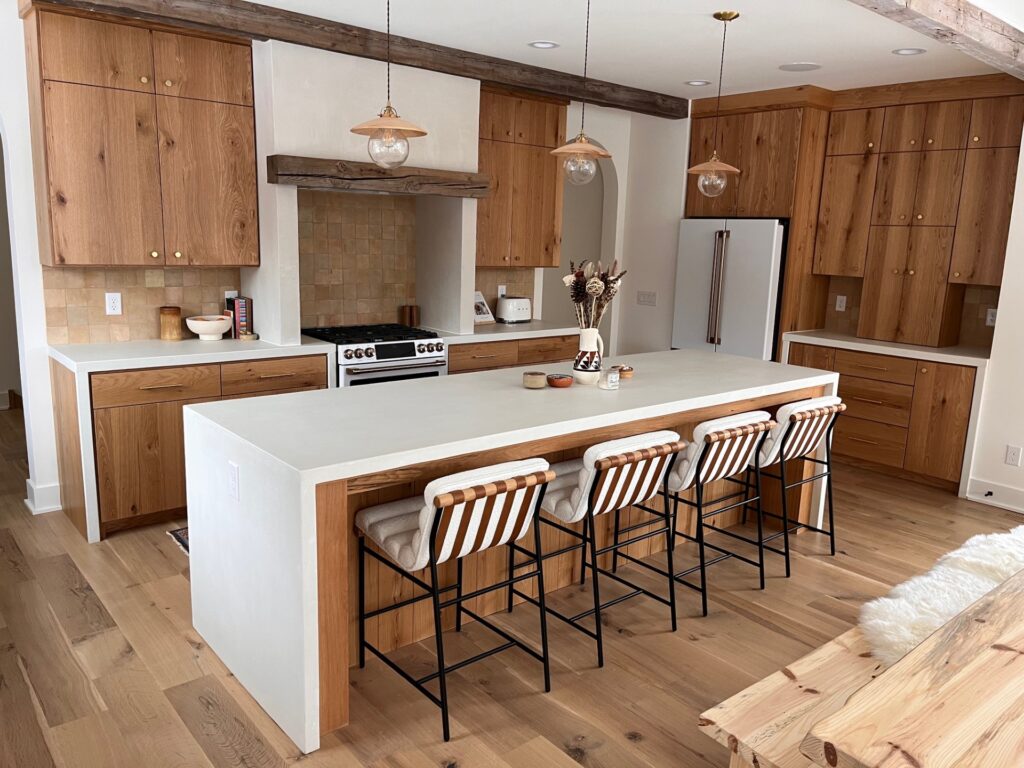
Key Benefits
-
Custom Colors and Patterns: Concrete can be dyed, acid-stained, or embedded with glass, shells, or other aggregates to achieve striking visual effects. This allows for a highly personalized kitchen island surface that reflects your unique taste.
-
Exceptional Heat Resistance: Concrete naturally tolerates high temperatures, making it suitable for islands incorporating cooktops or serving hot dishes.
-
Durability: When properly sealed, concrete is scratch-resistant, water-resistant, and capable of withstanding years of wear and tear.
Drawbacks to Consider
-
Requires Sealing: Concrete is porous by nature. Without a high-quality sealant, it can absorb moisture, oils, and food stains.
-
Installation Sensitivity: Improper installation or curing can lead to cracking over time. It is essential to work with experienced professionals when choosing concrete as your kitchen island material.
Ideal Application
Concrete is best suited for custom-designed kitchen islands in homes that favor bold, contemporary aesthetics. Its ability to be molded into unique shapes makes it ideal for waterfall edges, integrated sinks, and dramatic statement pieces.
🔗 View our project portfolio to explore concrete countertops implemented in stylish Maryland kitchens.
6. Laminate: Budget-Friendly Versatility with Modern Appeal
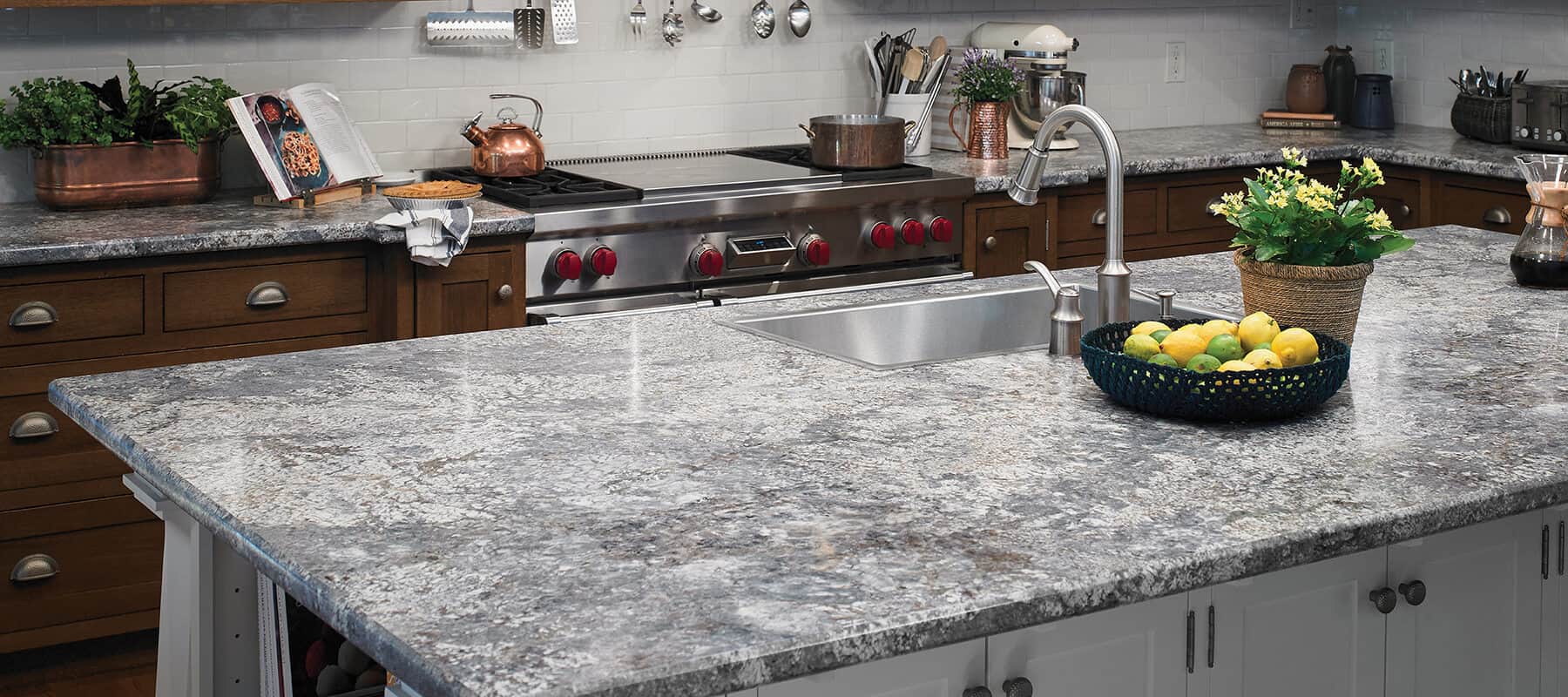
Once seen as an entry-level option, laminate countertops have experienced a renaissance thanks to advancements in manufacturing and design. Today’s laminates can convincingly mimic the look of wood, stone, and even concrete—making them a surprisingly stylish choice for budget-conscious homeowners.
Pros of Laminate Kitchen Island Countertops
-
Affordability: Laminate remains the most budget-friendly material for kitchen countertops. It’s perfect for homeowners looking to stretch their renovation dollars.
-
Ease of Installation: Lightweight and easy to cut, laminate is ideal for DIY installations or quick updates to existing kitchen islands.
-
Variety of Finishes: From faux marble to distressed wood, laminate offers a wide range of patterns, colors, and textures, making it adaptable to nearly any kitchen style.
Limitations to Keep in Mind
-
Not Heat-Resistant: Laminate surfaces can scorch or bubble when exposed to high temperatures, so always use trivets or heat pads.
-
Vulnerability to Moisture and Impact: The underlying particleboard can swell if water seeps through seams, and the surface is prone to chipping under heavy use.
Ideal Use
Laminate is perfect for DIY kitchen island projects, IKEA kitchen islands, or temporary renovations. It’s especially useful in rentals, guest kitchens, or secondary prep areas where style and affordability are the priority.
🔗 Learn more about budget-conscious upgrades in our article on kitchen remodeling trends and ideas.
7. Tile Countertops: Creative Freedom with a Classic Twist
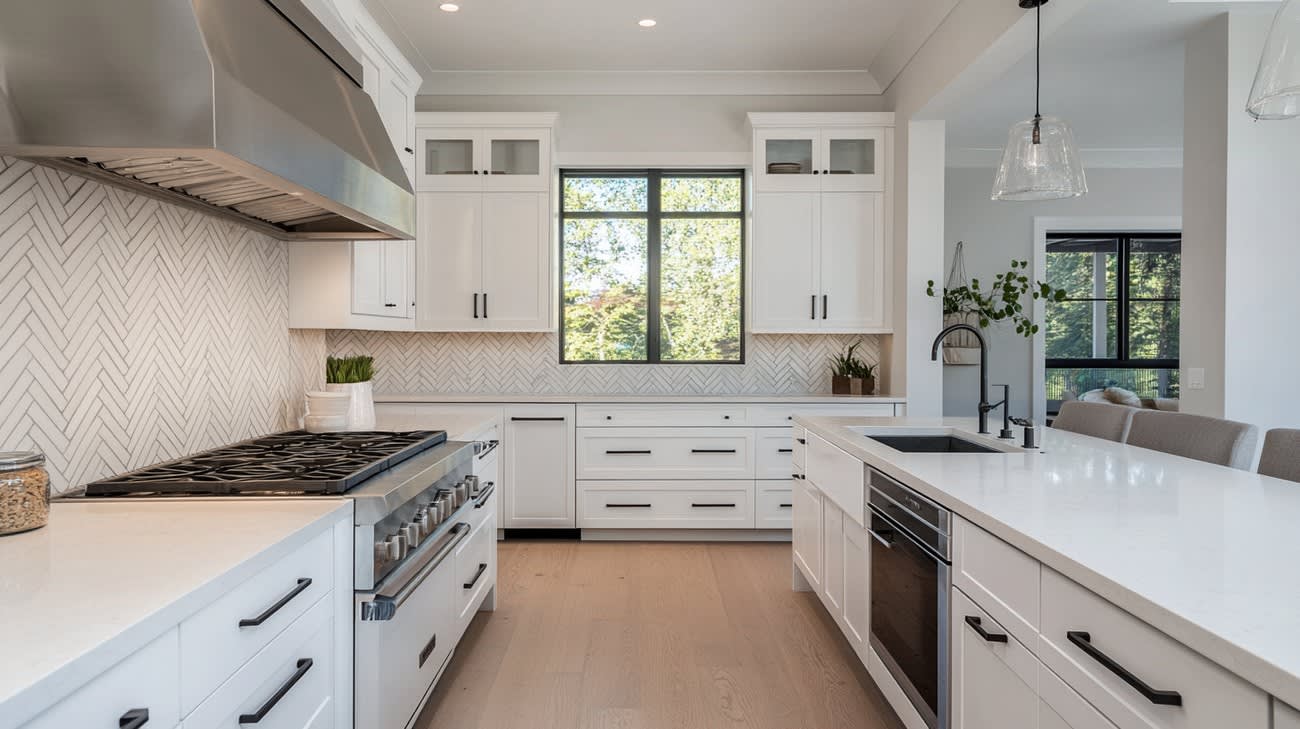
For homeowners who crave color, texture, and old-world charm, tile countertops offer unmatched creative freedom. With options ranging from ceramic and porcelain to natural stone, tile allows you to customize your kitchen island surface with a mix of shapes, hues, and styles.
Advantages of Using Tile
-
Excellent Heat Resistance: Tiles are naturally resistant to high temperatures, making them ideal for areas around stoves or ovens.
-
Affordability: Ceramic and porcelain tiles are typically less expensive than stone slabs and provide a budget-friendly option with high-end appeal.
-
Design Flexibility: You can choose from intricate mosaic designs, traditional subway tiles, or large-format porcelain slabs to achieve a distinctive look.
Challenges with Tile
-
Grout Maintenance: Grout lines are prone to staining and require periodic cleaning or sealing to maintain a fresh appearance.
-
Uneven Surface: Unlike solid slab materials, tile countertops can be bumpy or uneven, which may make tasks like rolling dough or writing less convenient.
Best Fit
Tile is well-suited for Mediterranean-style kitchens, eclectic interiors, and homeowners who enjoy incorporating colors and patterns into their space. It can also serve as a striking contrast to plain cabinetry or neutral flooring.
🔗 See how tile elements can complement your flooring choices in our blog on flooring solutions and style tips.
8. Outdoor Kitchen Island Materials: Built to Endure the Elements
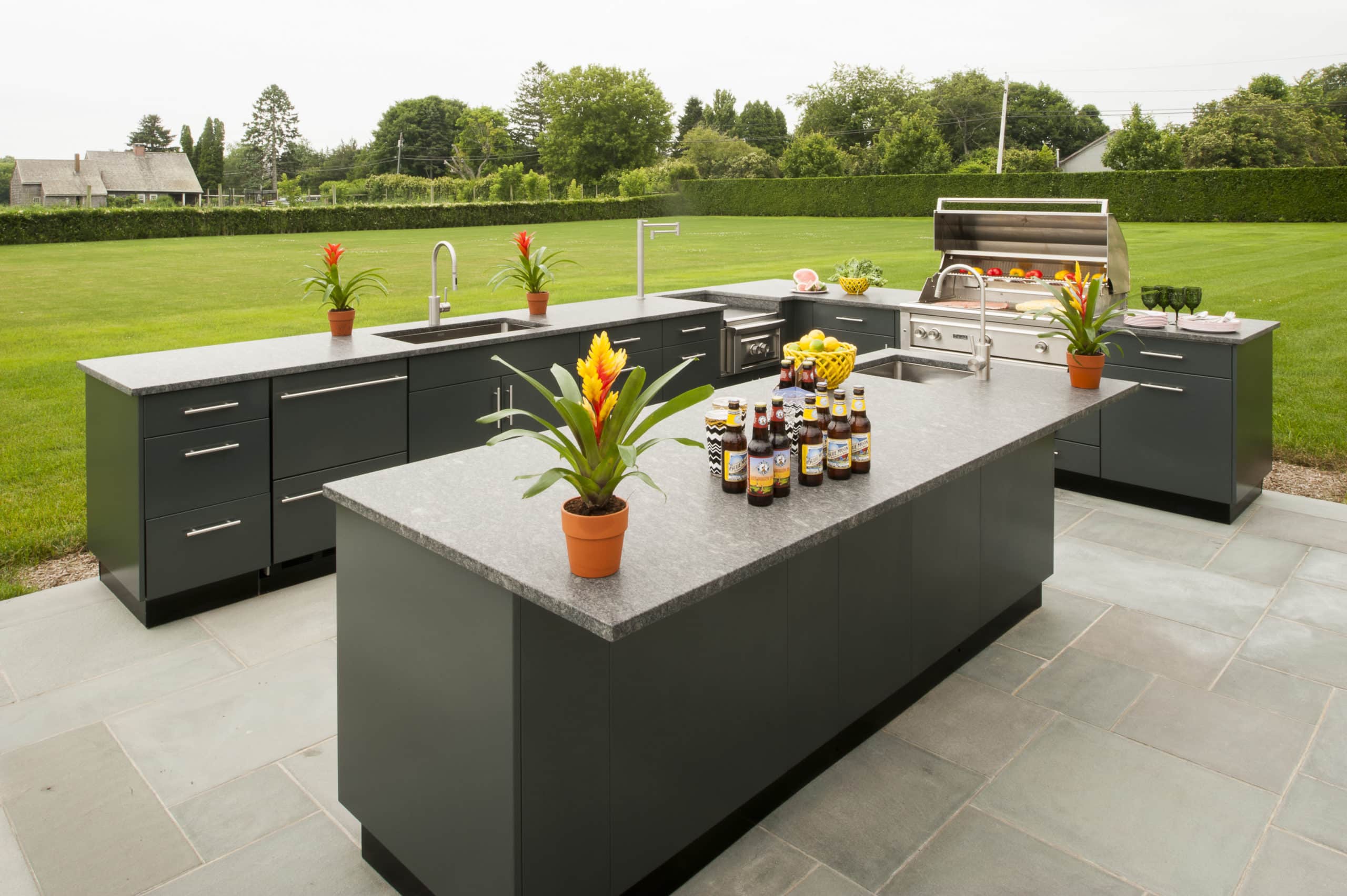
Designing a kitchen island for outdoor living requires a distinct set of material considerations. Exposure to sun, rain, humidity, and even snow demands that both your frame material and countertop be resilient and weather-resistant. The key is to select components that maintain their integrity and appearance year after year with minimal maintenance.
Best Materials for Outdoor Kitchen Island Frames
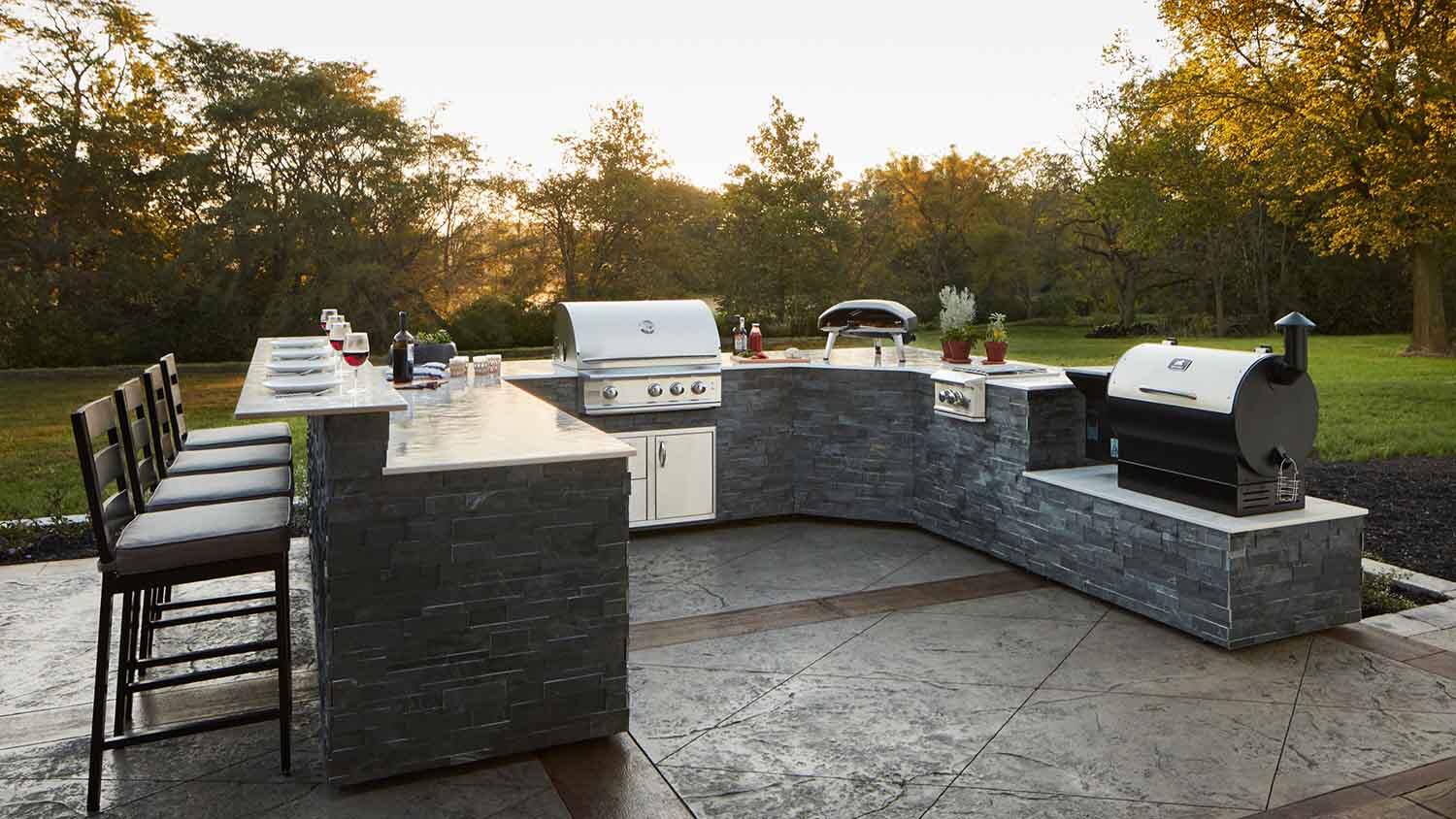
Choosing the right frame ensures structural integrity and provides a strong foundation for countertops, appliances, and storage features. Here are three leading options:
-
Concrete Blocks
One of the most popular materials for outdoor kitchen bases, concrete blocks are durable, cost-effective, and compatible with a variety of cladding materials like stucco, stone veneer, or tile. They offer excellent strength and won’t degrade in harsh climates. -
Steel (Galvanized or Stainless)
Galvanized or stainless steel frames are ideal for modular outdoor kitchens. These materials are lightweight, rust-resistant, and can support built-in grills and heavy countertops. However, they typically require additional finishing (like siding or weather-resistant panels) for aesthetics and protection. -
Wood Frames (Teak, Ipe, or Cedar)
For a natural, organic look, teak and ipe wood frames are prized for their moisture resistance and durability. However, they do need regular maintenance such as oiling and sealing to prevent fading or warping. Wood is best used under covered patios or pergolas to reduce exposure.
🔗 Discover more in our guide on home addition services, where outdoor kitchens and entertainment spaces come to life.
Durable Countertop Materials for Outdoor Kitchens
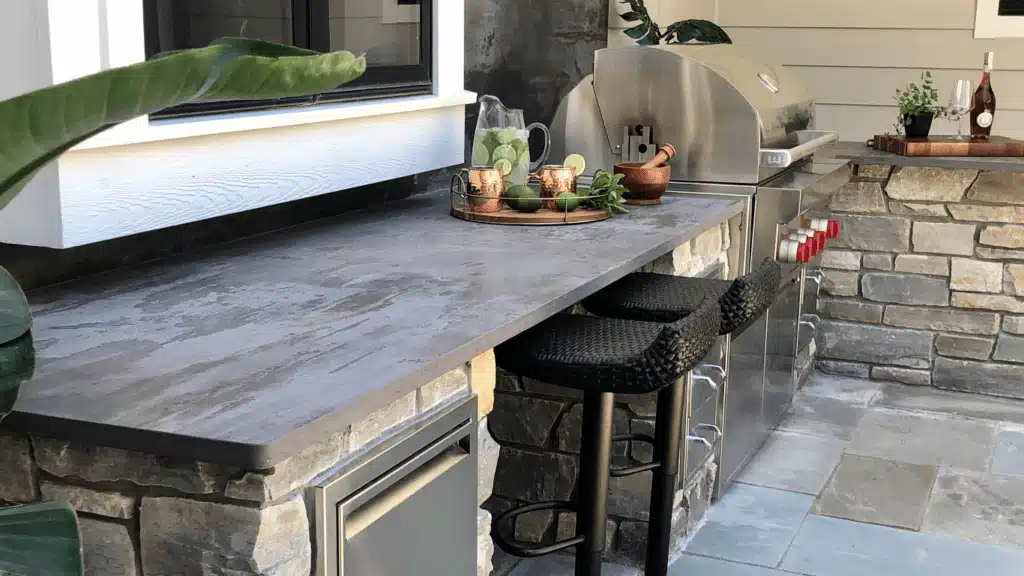
Your outdoor kitchen island countertop materials must hold up against UV rays, temperature changes, and moisture. Below are top-rated options:
-
Granite and Concrete
Both materials are highly durable and UV-resistant, making them excellent for uncovered outdoor islands. Granite offers rich visual appeal, while concrete allows for customization with dyes and patterns. Both require sealing to prevent moisture intrusion. -
Stainless Steel
A go-to for modern outdoor kitchens, stainless steel is rust-resistant and hygienic. It reflects heat, so in full sun, the surface may become hot to the touch. Nonetheless, it offers a sleek and professional look. -
Tile
A budget-friendly and visually versatile option, tile performs well outdoors when installed with weather-rated grout and sealants. Choose porcelain or natural stone tiles rated for exterior use to ensure longevity.
💡 Pro Tip: Don’t overlook the importance of documentation. Always check assembly and documents for warranties, maintenance instructions, and installation requirements to protect your investment.
Comparing Popular Kitchen Island Countertop Materials
To simplify your decision-making process, here is a comparison of the most common materials based on their durability, heat resistance, maintenance needs, and aesthetic versatility:
| Material | Durability | Heat Resistance | Maintenance | Aesthetic Range |
|---|---|---|---|---|
| Granite | High | Excellent | Moderate | High |
| Quartz | High | Moderate | Low | Very High |
| Butcher Block | Moderate | Low | High | High |
| Stainless Steel | High | Excellent | Low | Moderate |
| Concrete | High | Excellent | High | High |
| Laminate | Low | Low | Low | High |
| Tile | Moderate | Excellent | Moderate | Very High |
| Solid Surface | Moderate | Low | Low | High |
Use this table as a quick reference when matching kitchen island materials to your design and lifestyle goals.
Final Thoughts: How to Choose the Best Kitchen Island Material
Your kitchen island is more than a place to chop vegetables—it’s a core element of your kitchen’s layout, style, and functionality. Selecting the right material requires a careful balance between aesthetics, performance, and cost.
Here’s how to narrow your options:
-
Function: Will your island serve as a prep station, dining table, or storage hub? Each use may require different levels of heat resistance, scratch protection, or ease of cleaning.
-
Lifestyle: Households with children or avid cooks may benefit from non-porous, scratch-resistant surfaces like quartz or stainless steel.
-
Budget: If you’re working with a limited budget, laminate or tile can offer great visual appeal at a lower cost.
-
Design: Don’t forget about color harmony and finishes. Choose materials that match or contrast beautifully with your cabinets, flooring, and lighting. For cohesive results, try our multi-surface visualizer to experiment before installation.
Whether you’re investing in a built-in installation, purchasing a flexible IKEA kitchen island, or extending your kitchen into an outdoor living space, the material you choose plays a pivotal role in both the performance and visual appeal of your space.
Source Links
-
HGTV – Kitchen Island Countertops
https://www.hgtv.com/design/rooms/kitchens/kitchen-island-countertops -
The Spruce – Top Countertop Materials
https://www.thespruce.com/top-kitchen-countertops-1977143 -
Home Depot – Types of Countertops
https://www.homedepot.com/c/ab/types-of-countertops/9ba683603be9fa5395fab90f68e434e -
RTA Outdoor Living – Best Outdoor Kitchen Materials
https://rtaoutdoorliving.com/best-outdoor-kitchen-materials/ -
JSB Home Solutions – Kitchen Countertop Guide
https://www.jsbhomesolutions.com/learning-center/kitchen-countertop-best-materials


